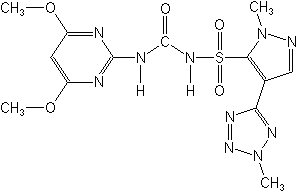-
Common NameAzimsulfuron
-
中文通用名四唑嘧磺隆
-
IUPAC1-(4,6-dimethoxypyrimidin-2-yl)-3-[1-methyl-4-(2-methyl-2H-tetrazol-5-yl)pyrazol-5-ylsulfonyl]urea
-
CASN-[[(4,6-dimethoxy-2-pyrimidinyl)amino]carbonyl]-1-methyl-4-(2-methyl-2H-tetrazol-5-yl)-1H-pyrazole-5-sulfonamide
-
CAS No.120162-55-2
-
Molecular FormulaC13H16N10O5S
-
Molecular Structure
-
Category
-
ActivityHerbicide.
Azimsulfuron is a post-emergence herbicide for the control of annual and perennial broadleaf weeds and sedges and barnyard grass (Echinochloa spp). The product is suitable for use in all rice cultivation systems. Azimsulfuron is particularly suitable for foliar application: since uptake by roots is less efficient than uptake by leaves and shoots. The product is translocated in the xylem and phloem and weeds are killed within three weeks of application. DuPont recommends applications from GS 14 to GS 21-23 of rice/1-4 leaf stage of Echinochloa. The use of surfactants enables optimum control of Echinochloa spp at the lower application rate.
The company recommend application into a very low flood (1-2 cm water) which should be maintained for 3-4 days after application.
In field trials, azimsulfuron gave similar control of Echinochloa spp to quinclorac + bensulfuron-methyl, but at much lower application rates. The reduction in application rate was even more marked by comparison with older herbicide products. -
CropUseCrop uses:
rice
Rice
20-25 g ai/ha
-
Physical PropertiesWhite powdery solid; Molecular weight: 424.4 g/mol; Melting Point: 170℃.
-
Toxicology(Rat): Oral LD50 >5000 mg/kg. Dermal LD50 >2000 mg/kg. Inhalation LC50 (4 h) >5.9 mg/l.
-
Environmental ProfileHAZARDS: Fish: LC50 (96 h) >300 ppm (carp); >1000 ppm (bluegill sunfish); 154 ppm (rainbow trout). LC50 (48 h) >1000 ppm (Daphnia). Bird: LD50 >2250 mg/kg (bobwhite quail, mallard duck). Dietary LC50 (8 d) >5260 mg/kg (bobwhite quail, mallard duck). Bee: LD50 (48 h) (Oral) >25μg/bee; (Contact) >1000μg/bee.
Bluegill sunfish [96 hrs]
LC50 >1,000 mg/litre
Bobwhite quail
LD50 >2,250 mg/kg
Rainbow trout [96 hrs]
LC50 >154 mg/litre
Mallard duck
LD50 >2,250 mg/kg
Daphnia magna [48 hrs]
EC50 941 mg/litre
Bee contact
LD50 >25 μg/bee
Bee ingestion
LD50 >1000 μg/bee
Fate in soil:
Azimsulfuron is degraded by microbial and chemical pathways in soil. Bio-accumulation in soil is not expected. The half-life in paddy soils is 11-24 days. Azimsulfuron has intermediate mobility in soil.Fate in aquatic systems:
Azimsulfuron is degraded in water by hydrolysis and by indirect photolysis (as a result of the action of light on other constituents in paddy water). The half-life is dependent on pH and ranges from 103 days at low pH to 225 days at higher pH. -
Transport InformationSignal Word:CAUTION; Hazard Class:III(Slightly hazardous)
Porduct NewsMore
Orthosulfamuron boosts sugarcane production, study finds
Glyphosate price plummets 40% in one year in Argentina
Indian govt stops imports of herbicide Glufosinate priced below Rs 1,289 per kg
Carbendazim fungicide wins victory in Brazilian Parliament
Corteva presents new pre-emergent herbicide Linear for sugarcane in Brazil
Picloram Triclopyr Aminopyralid
Revolutionizing disease prevention: BASF launches new rice fungicide Cevya® in China
Thiamethoxam is allowed again in Brazil by a judicial decision
Bayer develops alternative to glyphosate herbicide

 0
0 Subscribe
Subscribe
